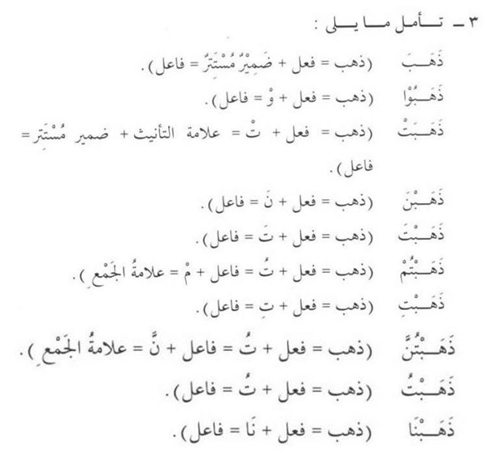Isnad fi'l madi to damir | Durusul lughah book2 - lesson 8
We've learned the process to add a suffix to fi'l madi for referring a particular subject pronoun (damir rafa' both damir mustatir and damir muttasil) in isnad fi'l madi to damir.
For example : we add suffix تَ to ذَهَبَ for referring أَنْتَ
I recommend you to review this lesson, after completing the lesson, you can continue reading this.
إِسْنَادُ الفِعْلِ المَاضِي إِلَى الضَّمَائِرِ ( a process to add suffix to fi'l madi for referring to it's subject pronoun)
a word by word translation of إِسْنَادُ الفِعْلِ المَاضِي إِلَى الضَّمَائِرِ
إِسْنَادٌ = the process to add suffix (for referring a particular fa'il/فَاعِل) to fi'l madi or fi'l mudari (in this case, we learn fi'l madi first).
الفِعْلِ المَاضِي = verb in past tense.
الضَّمَائِرُ = pronouns.
الضَّمَائِرُ is plural form of ضَمِيرٌ
In this case ضَمِيرٌ is acted as فَاعِلٌ/fa'il or the doer.
Summary of the translation
From the isnad process, we know sign of the correct pair fi'l and fa'il (verb and the doer).
for example :
ذَهَبَتْ
through isnad process, we know appropriately that fi'l madi ذَهَبَتْ refers the fa'il هِيَ
Observe the table below.
Let's take a look one by one.
1. الغائب والمذكّر والمفرد
gha-ib, mudhakkar, mufrad = 3rd person, masculine, singular => هُوَ (he)
example : حَامِدٌ ذَهَبَ
حَامِدٌ = hamid
ذَهَبَ = he went
the meaning : Hamid, he went.
For the sake of simplicity, we translate it to => Hamid went.
ذَهَبَ is fi'l madi, subject pronoun for ذَهَبَ is hidden pronoun "هُوَ "
in other word, fi'l madi ذَهَبَ and the fa'il is هُوَ or he (third person, masculine, singular). In this sentence the fa'il is Hamid.
note: subject pronoun is called damir rafa'.
2. الغائب والمذكّر والجمع
gha-ib, mudhakkar, jam' = 3rd person, masculine, plural => هُمْ (they)
example: حَامِدٌ وَهَاشِمٌ وَعَلِيٌّ ذّهّبُوا
حَامِدٌ وَهَاشِمٌ وَعَلِيٌّ = Hamid, Hashim, and Ali.
ذّهّبُوا = they went
the meaning : Hamid, Hashim, and Ali, they went.
For short, we translate it to = Hamid, Hashim, and Ali went.
ذّهّبُوا is fi'l madi.
The fa'il of ذّهّبُوا is وْ (al-waw jama'ah).
وْ refers to هُمْ (they), in this sentence the fa'il are hamid, hashim, and ali.
====*note*====
plural in Arabic is things more than two.
مفرد (singular) = one , example: كِتَابٌ ( a book)
مثنّى (dual) = two, example : كِتَابَانِ (two books)
جمع (plural) = more than two, example : كُتُبٌ (books)
====*note*====
3. الغائب والمؤنّث والمفرد
gha-ib, mu-annath, mufrad = 3rd person, feminine, singular => هِيَ (she)
example : آمِنَةُ ذَهَبَتْ
the meaning : Aminah, she went. For simplicity you can write "Aminah went."
ذَهَبَتْ is fi'l madi.
تْ in the end of this fi'l is called التاء التأنيث (ta ta'nith) or ta to show the fa'il is feminine.
the fa'il of ذَهَبَتْ is hidden pronoun "هِيَ " or she, in this sentence the fa'il is Aminah.
4. الغائب والمؤنّث والجمع
gha-ib, mu-annath, jam' = 3rd person, feminine, plural => هُنَّ (they)
example:
آمِنَةُ وَزَيْنَبُ وَمَرْيَمُ ذَهَبْنَ
the meaning : Aminah, Zainab, and Maryam went.
ذَهَبْنَ = fi'l madi
The fa'il of ذَهَبْنَ is nun an-niswah, refers to Aminah, Zainab, and Maryam.
5. المخاطب المذكّر المفرد
mukhatab, mudhakkar, mufrad = 2nd person, masculine, singular => أَنْتَ (you)
example :
أَنْتَ ذَهَبْتَ
the meaning : You went.
ذَهَبْتَ = fi'l madi
The fa'il of ذَهَبْتَ is تَ
تَ refers to أَنْتَ (you).
6. المخاطب المذكّر الجمع
mukhatab, mudhakkar, jam' = 2nd person, masculine, plural = > أَنْتُمْ (you)
example :
أَنْتُمْ ذَهَبْتُمْ
the meaning : You went
ذَهَبْتُمْ = fi'l madi
The fa'il of ذَهَبْتُمْ is تُ and مْ for indicating masculine plural (jam' mudhakkar).
تُمْ refers to أَنْتُمْ
7. المخاطب المؤنّث المفرد
mukhatab, mu-annath, mufrad = 2nd person, feminine, singular => أَنْتِ (you)
example:
أَنْتِ ذَهَبْتِ
the meaning : You went.
ذَهَبْتِ is fi'l madi
the fa'il of ذَهَبْتِ is تِ
تِ refers to أَنْتِ
8. المخاطب المؤنّث الجمع
mukhatab, mu-annath, jam' = 2nd person, feminine, plural => أَنْتُنَّ (you)
example:
أَنْتُنَّ ذَهَبْتُنَّ
the meaning : You went.
ذَهَبْتُنَّ is fi'il madi.
The fa'il of ذَهَبْتُنَّ is تُ and ن for indicating feminine plural (jam' mu-annath)
تُنَّ refers to أَنْتُنَّ
9. المتكلّم المذكّر والمؤنّث المفرد
al-mutakallim, mudhakkar & mu-annath, mufrad = 1st person, masculine and feminine, singular => أَنَا (I)
example:
أَنَا ذَهَبْتُ
the meaning : I went
ذَهَبْتُ is fi'il madi
The fa'il of ذَهَبْتُ is تُ
تُ refers to أَنَا
10. المتكلّم المذكّر والمؤنّث الجمع
mutakallim, mudhakkar & mu-annath, jam' = 1st person, masculine and feminine, plural => نَحْنُ (we)
example:
نَحْنُ ذَهَبْنَا
The meaning: We went
ذَهَبْنَا is fi'l madi
The fa'il of ذَهَبْنَا is نَا
نَا refers to نَحْنُ
Recap
1. ذَهَبَ = fi'l ذَهَبَ + damir mustatir (hidden pronoun) refers to هُوَ
2. ذَهَبُوْا = fi'l ذَهَبَ + fa'il وْ
3. ذَهَبَتْ = fi'l ذَهَبَ + ta ta'nith (تْ) + damir mustatir refers to هِيَ
4. ذَهَبْنَ = fi'l ذَهَبَ + fa'il نَ
5. ذَهَبْتَ = fi'l ذَهَبَ + fa'il تَ
6. ذَهَبْتُمْ = fi'l ذَهَبَ + fa'il تُ + mim (مْ) for indicating plural
7. ذَهَبْتِ = fi'l ذَهَبَ + fa'il تِ
8. ذَهَبْتُنَّ = fi'l ذَهَبَ + fa'il تُ + nun (نَّ) for indicating plural
9 . ذَهَبْتُ = fi'l ذَهَبَ + fa'il تُ
10. ذَهَبْنَا = fi'l ذَهَبَ + fa'il نَا
Summary damir muttasil
1. damir التّاء (ta) = ذَهَبْتَ , ذَهَبْتِ , ذَهَبْتُ, ذَهَبْتُمْ , ذَهَبْتُنَّ
2. damir الواو (waw) = ذَهَبُوْا
3. damir النّون (nun) = ذَهَبْنَ
4. damir نَا (naa) = ذَهَبْنَا





No comments:
Post a Comment